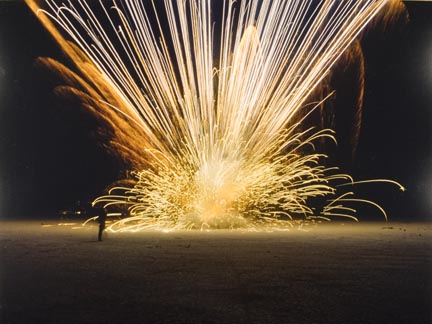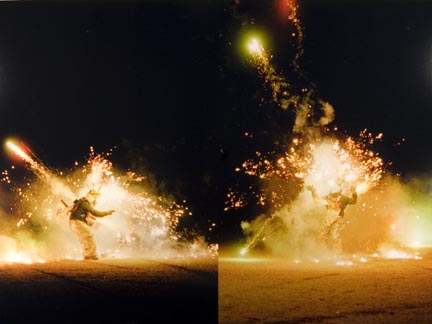About the Photographer
Roberts, Simon
British, b. 1974
Simon Roberts has a continuing interest in the idea of national identity and what he describes as "social landscapes." He began as a photojournalist, working on location throughout Europe, Africa, and the United States, but in recent years Roberts has also pursued rigorous independent projects. In these extensive series of photographs Roberts gives equal attention to the details of individual lives and the shape of collective experience on a larger scale.
In 1999 Roberts attended and documented an illegal gathering of pyrotechnics enthusiasts in the Nevada desert called Desert Blast. Held in a secret location the event’s main activities included flamethrower demonstrations, the detonation of high-powered rockets, and explosions reaching hundreds of feet in the air. In an interview, the founder of Desert Blast once described the gathering as “our rebel breakaway from all the government agencies and professionals who have neutered the fun of fireworks; it’s our freedom-loving release.†Eventually the event was reported to law enforcement agents and cancelled, but it was re-instated in 2002 with the new name "Winter Blast" and the official sanction of the town of Lake Havasu, Arizona. The renewed proceedings, however, were much tamer and obviously organized as a patriotic rallying cry to support the war in Iraq. In one section called “American Heroes,†a fireworks display was accompanied by a voice-over of President George W. Bush speaking about 9/11. Together, Roberts' two series depicting these events speak to the tension between the idea of American freedom and the regulated society in which Americans live.
Roberts's later photographic essay, Motherland (2005), was created during a year-long journey through Russia. This empathic collection of photographs, which combines intimate portraits and expansive landscapes, coalesces into a picture of post-Soviet Russia that is more complex and optimistic than clichéd portrayals of poverty in the wake of Communism. Offering equal measures of beauty and disorder, pride and melancholy, the images suggest a sense of belonging and a common spirit amidst evident diversity. Coming through centrally in Motherland is the importance of place and the native landscape to the Russian people. Roberts’s photograph of taxis on the frozen Lena River, for instance, encapsulates the sheer enormity of the country and the austere grandeur of the land, while embodying the sense of a nation moving into a new and unfamiliar era.
Following this photographic study of life in Russia, Roberts commenced a project that involved another extended journey, this time throughout his home country of England. His aim in this case is to describe the English social landscape and the elusive qualities of a shared experience there, spanning geographic and demographic differences. Roberts earned a BA in human geography from University of Sheffield (1996) and a Distinction in Photography from the National Council for the Training of Journalists (1997).



